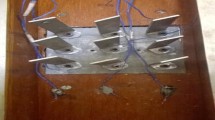Abstract
It is essential to provide adequate cooling in electronic components to avoid overheating and increase the performance of the system. Recognizing the poor heat transfer performance of air-cooling, secondary fin surface is usually exploited to solve the increased demand of heat dissipating. For further improvement of the overall heat transfer performance, augmentation via fin pattern is often employed. Among the fin configurations being implemented in practical applications, pin fin is regarded as one of the most effective heat transfer augmentation methods for providing boundary layer restarting and periodic vortex shedding. For rectangular plate fin heat sinks it has been observed that there is boundary layer growth in forced convection, which decreases the heat transfer rate. To overcome this problem, some circular fins are inserted in the passage of plate fin. By doing so an average heat transfer coefficient of the rectangular plate pin fin heat sink (PPFHS) was increased compared to rectangular plate fin heat sink (PFHS) under the condition of equal wind velocity. A comparative study of plate fin heat sinks and plate pin fin heat sinks having circular cross-section pin over vertical base was done and it is found that for an inline arrangement, circular pin fin shows an appreciable influence of fin density, fin spacing. This is associated with the unique deflection flow pattern accompanied with the inline circular configuration. The present study carries out the parametric, numerical computations of the plate-circular pin-fin heat sink on vertical base and provides physical insight into the flow and heat transfer characteristics in forced convection. The parameters such as fin spacing, fin density, heat input and Reynolds number has been varied to observe the variation of thermal performance PFHS and PPFHS on vertical base. Limited experimentation is carried out to validate the numerical model. Numerical analysis is carried out to compare thermal performance of plate fin and plate pin fin heat sink under the condition of equal temperature difference between mean sink temperature and the ambient temperature. The effect of fin spacing, pin fin diameter and temperature difference between fin and surroundings on the forced convection heat transfer from vertical fin arrays were studied. The analysis have been carried out for the two type of heat sinks with three different spacing, three different pin diameters and five temperature differences. The result shows that there is 18–22% increase in rate of heat transfer and 20–25% increase in profit factor for PPFHS as compared to PFHS on vertical base.

















Similar content being viewed by others
Abbreviations
- Dh :
-
Hydraulic diameter
- f:
-
Flow variable
- f′:
-
Fluctuating value of flow variable
- \({\bar{\text{f}}}\) :
-
Average value of flow variable
- h:
-
Heat transfer coefficient, W/m2 K
- hav :
-
Average heat transfer coefficient, W/m2 K
- H:
-
Fin height, m
- J:
-
Profit factor
- K:
-
Conductivity of air
- l:
-
Characteristic length
- L:
-
Fin length, m
- Nu:
-
Nusselt number = \({\text{h}}_{\text{av}} {\text{l/K}}\)
- P:
-
Pumping power
- Pr:
-
Prandtl number
- \({\dot{\text{Q}}}\) :
-
Heat transfer rate, W
- Qin :
-
Heat input, W
- Re:
-
Reynolds number = \({\uprho\text{VD}}_{\text{h}} {/\upmu}\)
- S:
-
Fin spacing, m
- t:
-
Fin thickness, m
- T:
-
Temperature, K
- Tb :
-
Temperature at base
- Ts :
-
Temperature within heat sink
- u, v, w:
-
Velocity in x, y and z directions, respectively
- V:
-
Velocity of air
- ε:
-
Emissivity
- \(\Gamma\) :
-
Diffusion coefficient of air
- \({\uplambda }_{\text{s}}\) :
-
Heat sink thermal conductivity
- μ:
-
Dynamic viscosity
- ρ:
-
Density of air
References
A. Bar-Cohen, W.M. Rohsenow, Thermally optimum arrays of cards and fins in natural convection. IEEE Trans. Compon. Hybrids Manuf. Technol. 6(2), 154–158 (1983)
X. Yu, J. Feng, Q. Feng, Q. Wang, Development of a plate-pin fin heat sink and its performance comparisons with a plate fin heat sink. Appl. Therm. Eng. 25, 173–182 (2005)
N. Sahiti, F. Durst, A. Dewan, Heat transfer enhancement by pin elements. Int. J. Heat Mass Transf. 48, 4738–4747 (2005)
A.K.-S. Yang, B.W.-H. Chu, B.I.-Y. Chen, C.-C. Wang, A comparative study of the airside performance of heat sinks having pin fin configurations. Int. J. Heat Mass Transf. 50, 4661–4667 (2007)
N. Sahiti, F. Durst, A. Dewan, Strategy for selection of elements for heat transfer enhancement. Int. J. Heat Mass Transf. 49, 3392–3400 (2006)
R.F. Babus’Haq, K. Akintunde, S.D. Probert, Thermal performance of a pin fin assembly. Int. J. Heat Fluid Flow 16, 50–55 (1995)
K.A. Moores, Y.K. Joshi, Numerical and experimental characterization of a liquid cooled AlSiC power electronics base plate with integral pin fins, The Seventh Intersociety Conference on Thermal and Thermo-Mechanical Phenomena in Electronic Systems, Las Vegas, vol. 2, 385–390, 2000
P. Bergelin, G.A. Brown, S.C. Doberstein, Heat transfer and fluid friction during flow across banks of tubes—IV. A study of the transition zone between viscous and turbulent flow. Trans. ASME 74, 953–960 (1952)
E.M. Sparrow, J.W. Ramsey, C.A.C. Altemani, Experiments on in-line pin fin arrays and performance comparisons with staggered arrays. J. Heat Transf. Trans. ASME 102, 44–50 (1980)
Acknowledgements
Authors are thankful for the financial support received from Board of College and University Development, Savitribai Phule Pune University through the research grant to carry out the research work reported in this paper and College of Engineering, Pune for technical support.
Author information
Authors and Affiliations
Corresponding author
Rights and permissions
About this article
Cite this article
Kamde, G.E., Dingare, S.V. Experimental and Computational Investigation of Forced Convection Analysis of Plate Circular Pin Fin Heat Sinks over Vertical base. J. Inst. Eng. India Ser. C 99, 503–512 (2018). https://doi.org/10.1007/s40032-017-0363-0
Received:
Accepted:
Published:
Issue Date:
DOI: https://doi.org/10.1007/s40032-017-0363-0




